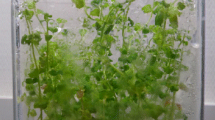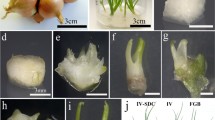Abstract
The possibility of streamlining general cryoprotection procedures is investigated using aluminium cryoplates with wells, facilitating fluid handling and drying treatment. Precultured shoot tips of potato cultivar ‘Sayaka’ were embedded in calcium alginate gel in wells of the aluminium cryo-plates. In the V cryo-plate protocol, dehydration was performed for 30 min at 25 °C in plant vitrification solution after osmoprotection. In the D cryo-plate protocol, dehydration was performed by placing the cryo-plates for 2.0 h under an air current in a laminar flow cabinet after osmoprotection. In both protocols, cooling was performed by placing the cryo-plates in uncapped cryotubes, which were immersed in liquid nitrogen. For rewarming, the cryo-plates were immersed in liquid MS medium supplemented with 1.0 M sucrose and diluted for 15 min at room temperature. Under these conditions, regrowth rates of cryopreserved shoot tips in V cryo-plate and D cryo-plate were 96.7 and 93.3 %, respectively. Both protocols will facilitate efficient strategies for preservation, storage, and maintenance of genetic stability of important potato germplasm.
Resumen
Se investigá la posibilidad de realizer procedimientos generales de crioprotección mediante el uso de crioplacas de aluminio con cavidades, facilitando el manejo fluido y tratamiento de secado. Se colocaron ápices de tallo de papa pre-cultivados, de la variedad “Sayaca” en crio placas de aluminio y se embebieron en de alginato de calcio. En el protocolo de crio placa -V se hizo la deshidratación por 30 min a 25 °C en una solución de vitrificación de planta después de osmoprotección. En el protocolo de crio placa -D, la deshidratación se hizo colocándolas por 2 h bajo una corriente de aire en una cámara de flujo laminar después de la osmoprotección. En ambos protocolos, el enfriamiento se realizó mediante la colocación de las crio placas en crio tubos sin tapa, que fueron inmersos en nitrógeno líquido. Para la secuperacid se sumergieron las crio placas en un medio líquido MS suplementado con 1.0 M de sacarosa en dilución por 15 min a temperatura ambiente. Bajo estas condiciones, los niveles de secuperacion de los ápices de tallo criopreservados en crio placas -V y -D fueron de 96.7 y 93.3 %, respectivamente. Ambos protocolos facilitarán las estrategias eficientes para preservación, almacenamiento, mantenimiento y estabilidad genética de germoplasma de importacia de accesiones de papa.

Similar content being viewed by others
References
Engelmann, F., M.T. Gonzalez-Arnao, Y. Wu, and R. Escobar. 2008. The development of encapsulation dehydration. In Plant cryopreservation: A practical guide, ed. B.M. Reed, 59–75. New York: Springer.
Folgado, R., K. Sergeant, J. Renaut, R. Swennen, J.-F. Hausmman, and B. Panis. 2014. Changes in sugar content and proteome of potato in response to cold and dehydration stress and their implications for cryopreservation. Journal of Proteomics 98: 99–111.
Golmirzaie, A.M., and A. Panta. 2000. Advances in potato cryopreservation at CIP. In Cryopreservation of tropical germplasm –current research progress and application, ed. F. Engelmann and H. Takagi, 250–254. Rome: IPGRI.
Hirai, D. 2011. Gelled droplet vitrification improves recovery of cryopreserved potato germplasm. CryoLetters 32: 287–296.
Hirai, D., and A. Sakai. 1999. Cryopreservation of in vitro grown meristems of potato (Solanum tuberosum L.) by encapsulation vitrification. Potato Research 42: 153–160.
Kaczmarczyk, A., N. Shvachko, Y. Lupysheva, M.R. Hajirezaei, and E.R.J. Keller. 2008. Influence of alternating temperature preculture on cryopreservation results for potato shoot tips. Plant Cell Reports 27: 1551–1558.
Keller, E.R.J., A. Kaczmarczyk, and A. Senula. 2008. Cryopreservation for genebanks – a matter between high expectations and cautious reservation. CryoLetters 29: 53–62.
Kim, H.H., J.W. Yoon, L.E. Park, E.G. Cho, J.K. Sohn, T.S. Kim, and F. Engelmann. 2006. Cryopreservation of potato cultivated varieties and wild species: Critical factors in droplet vitrification. CryoLetters 27: 223–234.
Murashige, T., and F. Skoog. 1962. A revised medium for rapid growth and bioassays with tobacco tissue cultures. Physiologia Plantarum 15: 473–487.
Niino, T., S. Yamamoto, K. Fukui, C.R. Castillo Martínez, M. Valle Arizaga, T. Matsumoto, and F. Engelmann. 2013. Dehydration improves cryopreservation of mat rush (Juncus decipiens Nakai) basal stem buds on cryo-plates. CryoLetters 34: 549–560.
Nishizawa, S., A. Sakai, Y. Amano, and T. Matsuzawa. 1992. Cryopreservation of asparagus (Asparagus officinalis L.) embriogenic suspension cells and subsequent plant regeneration by simple freezing method. CryoLetters 13: 379–388.
Panta, A., B. Panis, C. Ynouye, R. Swennen, and W. Roca. 2014. Development of a PVS2 droplet vitrification method for potato cryopreservation. CryoLetters 35: 255–266.
Reed, B.M., I. Kovalchuk, S. Kushnarenko, A. Meier-Dinkel, K. Schoenweiss, S. Pluta, K. Straczynska, and E.E. Benson. 2004. Evaluation of critical points in technology transfer of cryopreservation protocols to international plant conservation laboratories. CryoLetters 25: 341–352.
Sakai, A. 1990. Development of PVS-based vitrification and encapsulation-vitrification protocols. In Plant cryopreservation: A practical guide, ed. B.M. Reed, 33–58. New York: Springer.
Schäfer-Menuhr, A., H.M. Schumacher, and G. Mix-Wagner. 1997. Cryopreservation of potato cultivars –design of a method for routine application in genebanks. Acta Horticulturae 447: 477–482.
Sekizawa, K., S. Yamamoto, T. Rafique, K. Fukui, and T. Niino. 2011. Cryopreservation of in vitro-grown shoot tips of carnation (Dianthus caryophyllus L.) by vitrification method using aluminum cryo-plates. Plant Biotechnology 28: 401–405.
Tanaka, D., A. Nishiuchi, T. Niino, and T. Matsumoto. 2011. A comparison of vitrification and droplet vitrification procedures for the cryopreservation of in vitro grown black chokeberry shoot tips. Acta Horticulturae 908: 325–330.
Yamamoto, S., K. Fukui, T. Rafique, N.I. Khan, C.R. Castillo Martinez, K. Sekizawa, T. Matsumoto, and T. Niino. 2011a. Cryopreservation of in vitro-grown shoot tips of strawberry by the vitrification method using aluminum cryo-plates. Plant Genetic Resources: Characterization and Utilization 10: 14–19.
Yamamoto, S., T. Rafique, W.S. Priyantha, K. Fukui, T. Matsumoto, and T. Niino. 2011b. Development of a cryopreservation procedure using aluminum cryo-plates. CryoLetters 32: 256–265.
Yamamoto, S., T. Rafique, K. Fukui, K. Sekizawa, A. Koyama, T. Ichihashi, and T. Niino. 2012a. Development of an effective cryopreservation protocol using aluminum cryo-plates for in vitro-grown shoot tips of mulberries (Morus spp.) originated from the tropics and subtropics. Sanshi-Konchu Biotechnology 81: 57–62 (in Japanese).
Yamamoto, S., T. Rafique, K. Fukui, K. Sekizawa, and T. Niino. 2012b. V-Cryo-plate procedure as an effective protocol for cryobanks. Case study of mint cryopreservation. CryoLetters 33: 12–23.
Acknowledgments
We are grateful to Dr. B. A. Antonio for critical reading the manuscript and to Ms. N. Nohara, Ms. A. Nishiuchi, Ms. N. Ishikura and Ms. Y. Sato for their excellent technical assistance. This work was mainly supported by a grant from the Ministry of Agriculture, Forestry, and Fisheries of Japan (Genomics-based Technology for Agricultural Improvement, CRS-1001, CRS-1002) and was partially supported by JST/JICA, SATREPS: Diversity Assessment and Development of Sustainable Use of Mexican Genetic Resources.
Author information
Authors and Affiliations
Corresponding author
Rights and permissions
About this article
Cite this article
Yamamoto, Si., Wunna, Rafique, T. et al. The Aluminum Cryo-plate Increases Efficiency of Cryopreservation Protocols for Potato Shoot Tips. Am. J. Potato Res. 92, 250–257 (2015). https://doi.org/10.1007/s12230-014-9425-5
Published:
Issue Date:
DOI: https://doi.org/10.1007/s12230-014-9425-5




